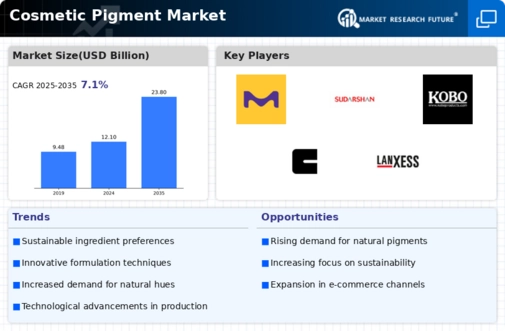Market Share
Cosmetic Pigments Market Share Analysis
In the vibrant and competitive arena of the cosmetic pigments market, companies employ a variety of strategies to establish their presence and capture market share. One prevalent strategy is differentiation, where companies highlight the unique properties or characteristics of their cosmetic pigments to distinguish themselves from competitors. For instance, some companies may emphasize the vibrant color range, long-lasting durability, or skin-friendly formulations of their pigments, making them particularly appealing to cosmetics manufacturers and consumers. By accentuating these distinctive features, companies can attract customers seeking high-quality and innovative pigments, thus carving out a niche within the market.
Cost leadership is another significant strategy, with companies aiming to offer competitive pricing while maintaining profitability. Through efficient manufacturing processes, strategic sourcing of raw materials, and economies of scale, these companies can provide cosmetic pigments at lower costs compared to their rivals. This approach appeals to cost-conscious cosmetics manufacturers looking to minimize production expenses without compromising on product quality or performance. By positioning themselves as cost leaders, companies can capture market share among budget-conscious buyers and strengthen their position in the market.
Moreover, companies may opt for a niche market strategy, targeting specialized segments or applications within the cosmetic pigments market. Instead of competing across the entire market spectrum, they focus their efforts on serving specific customer needs or addressing unique industry requirements. For example, a company might specialize in providing natural or organic pigments for eco-conscious cosmetics brands, where sustainability and safety are paramount. By catering to niche markets, companies can develop expertise, build strong customer relationships, and establish themselves as leaders within their chosen segments.
Branding and marketing play a pivotal role in market share positioning strategies within the cosmetic pigments market. Building a strong brand identity helps companies differentiate themselves, cultivate customer loyalty, and command premium pricing. Through targeted marketing campaigns, companies can raise awareness about their products, communicate key benefits, and influence consumer perceptions. Whether through social media, influencer collaborations, or participation in industry events, effective marketing efforts enhance visibility and drive demand for cosmetic pigments, ultimately contributing to market share expansion.
Strategic partnerships and collaborations also feature prominently in market share positioning strategies. By forming alliances with cosmetics manufacturers, raw material suppliers, or regulatory agencies, companies can leverage complementary strengths and resources to gain a competitive edge. Collaborative ventures enable companies to access new markets, enhance product development capabilities, and stay ahead of industry trends. Through strategic partnerships, companies can expand their market reach, capitalize on growth opportunities, and strengthen their position in the cosmetic pigments market.
Innovation serves as a cornerstone of market share positioning strategies in the cosmetic pigments market. Companies invest in research and development to introduce new color shades, improve formulation techniques, or develop pigments with unique effects and properties. Whether it's creating pigments with enhanced color intensity, light reflectivity, or texture, innovation drives differentiation and stimulates market growth. Companies that prioritize innovation can capture market share by offering cutting-edge pigments that meet the evolving demands of cosmetics brands and consumers.
Customer experience and service quality are also critical components of market share positioning strategies. Providing excellent technical support, color matching services, and timely delivery fosters trust and loyalty among customers. Companies that prioritize customer satisfaction can differentiate themselves from competitors and build long-lasting relationships with clients. Positive experiences lead to repeat business, referrals, and positive word-of-mouth, ultimately contributing to market share expansion and sustained growth.








Leave a Comment